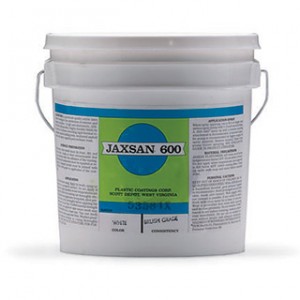I won’t have too many articles on just a product, and generally will just link to products in Amazon so you can know what they are if you don’t already. Today we have an exception, because it’s such a niche product that is special. Jaxsan 600 is one of my favorite materials for texturing or sealing surfaces. It’s durable and does what I tell it to. What more could a scenic artist want?
Jaxsan is a goopy, gritty texturing kind of substance. It’s a flexible acrylic (the fancy-pant term is elastometric) and while “Jaxsan” is the brand name, I’ve tried other brands (i.e. Henry’s from Home Depot) and was not as pleased with the product for theatrical purposes. It comes with a few different numbers in the title, but for theatrical purposes the 600 line is the stuff to get. It comes in a few thicknesses, from brush on to trowel grade. The trowel grade is thicker, but they all have a gritty thickish texture.
In many ways it acts like joint compound that’s been slightly thinned with sawdust added, however it’s got some added bonuses. (Joint compound with sawdust will give you splinters. This won’t… and this comes premixed to the right consistency.)
The Pros
Fire retardant
You don’t need to add additional flame-proofing in most theatrical applications.
Water resistant
If you paint over joint compound a lot, you know that working at all wet is a no-no unless you want the color of the joint compound to bleed through, because no matter how dry it was, it can be rewet and softened up again. Once Jaxsan is dry, it’s dry.
Stickable
This stuff sticks to a lot of surfaces that other texture compounds don’t like as much. Wood, cloth , foam, masonry, and a lot of plastics are all very happy to stick to this stuff. I use it most often on carved foam.
Thinable and Tintable
Jaxsan 600 can be thinned with water. It can be tinted with tints or standard latex/ acrylic paints. Recently I’ve been buying it from BMI Supply, where they carry a variety of sizes, colors and thicknesses… including white, grey, tan and white and 1, 2 and 5 gallon containers.
Applies a variety of ways
You can apply this with a brush, trowel, puddy knife, wallpaper paste brush, texturing roller or with anything else you use to apply textures. Just beware the clean-up caution. I don’t think I would apply this more thickly than a quarter inch at a time or half inch total in a few coats, because the top has a tendency to dry faster than the underside when applied thickly, so I’m not sure the underside would ever dry if it were too thick.
Durability
So if you put this on a flexible or squishable non-porous surface (i.e.- when I use this on the pipe insulation foam tube that I like to use as molding detail), it can flake off if the surface flexes or gets squished. On a porous surface, flexing and abusing this product doesn’t matter. Once it’s there, it’s there to stay.
Weather resistant
This stuff was designed for use in roofing, so it will live up against the elements. This is especially beneficial for use in “rain or shine” outdoor productions or on scenery that must survive special effects that include flying water.
The Cons
Clean-up
No matter how long I wash, this stuff never seems to come all the way out of a brush. It’s the gritty texture that tends to end up stuck there. I always use chip brushes with this that I can throw away. It also doesn’t like to come off your skin after drying there, so wear gloves. (It’s probably not healthy to get on your skin anyway.)
Cost
Two gallons of this runs about $75, and a five gallon pail runs about $180. You can get it a bit cheaper if you shop around. Jaxan is more expensive than a joint compound, sawdust and glue mixture. In fact, cost is probably the biggest reason this product isn’t used more often. For anything within reach of actors, however, it is worth the cost.
After drying adjustments
This stuff isn’t really sandable or carvable or anything once it’s dry. SO, once it’s dry it’s dry and there and done. The only option to change it is to add more. 